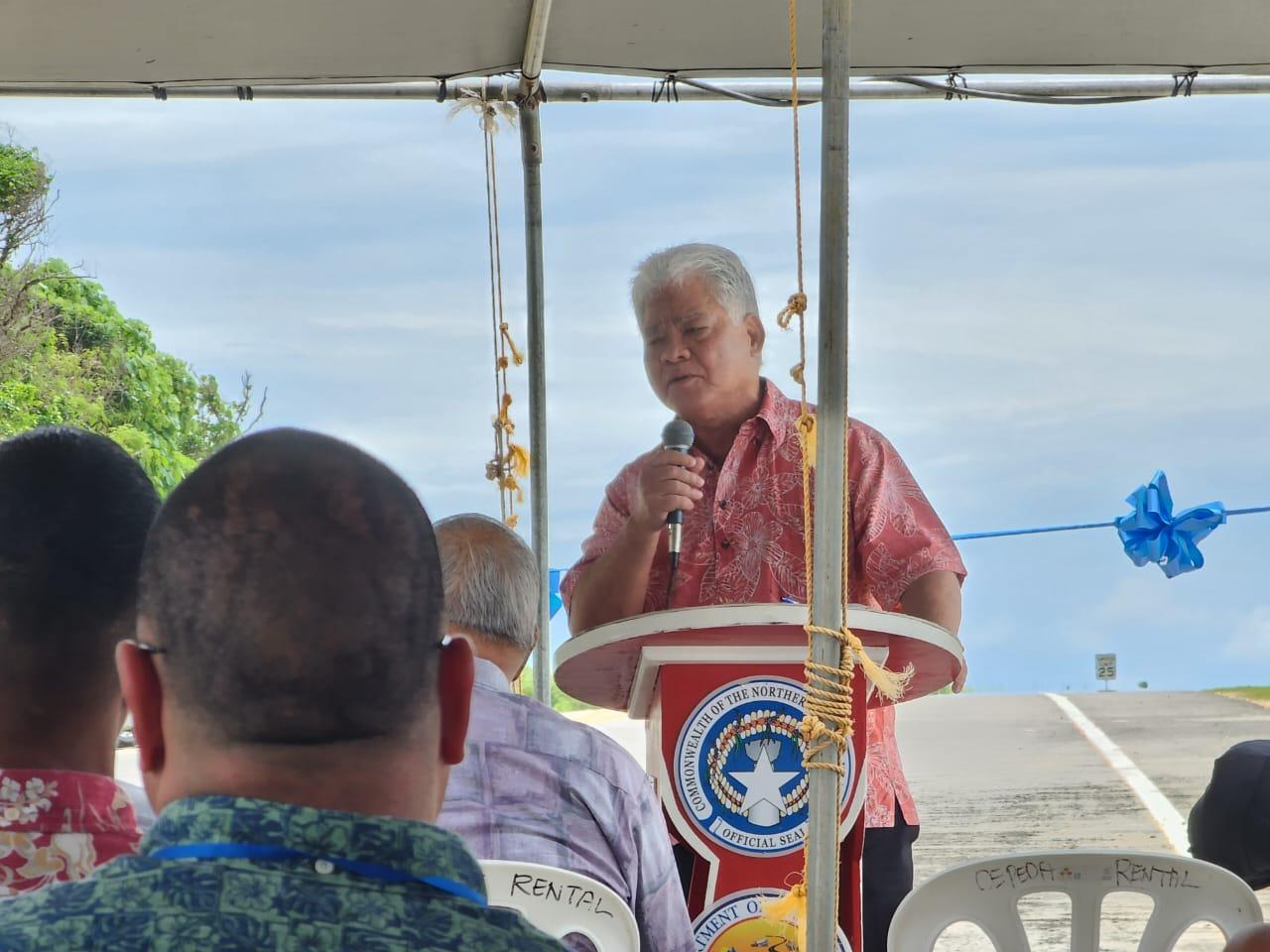Arnold Palacios’ pivot from China, though criticized by some who are used to the get-rich-quick schemes of the Chinese infiltrators, stands to pay off in a big, sustainable way through a new economic leg for the CNMI: the U.S. military.
But that’s only if the governor can succeed in convincing the CNMI people that Chinese tourists and investors should be part of a dark, embarrassing past for the CNMI.
That convincing has one major impediment: a misconception about what the Pacific military buildup is about, and a major misconception that only Guam will be benefiting from it.
The Defense buildup
According to the U.S. Defense Department’s Pacific Deterrence Initiative (or PDI), all four main branches of the military will spend $34 billion on a buildup of forces in the Indo-Pacific region west of the International Date Line. While some of that money will be spent on U.S. bases in Japan, South Korea, Australia, and other allied nations, the most important defenses will be built on U.S. soil.
There only are two U.S. jurisdictions in the INDOPACOM area of responsibility west of the IDL: Guam and the CNMI. And while the major program of the buildup for Guam is the Missile Defense System, the military has been eyeing the CNMI – Tinian, Pagan, and Saipan – for significant Defense investments.
A major component of the military buildup is the ability for the United States and its allies’ militaries to train for battle together in this region, according to Major Diann Rosenfeld, public affairs officer for U.S. Marine Corps Guam.
The DOD has termed one of these training programs as the Combined Joint Military Training (CJMT) proposal. The CNMI, according to a publication in Marine Corps University by Evan Polisar, is pivotal to that CJMT.
In fact, “the CNMI is expected to play an important role in maintaining American combat readiness in the Western Pacific,” according to Mr. Polisar’s paper. [According to the paper, “Evan N. Polisar is a senior legislative assistant and committee associate for a member of the U.S. House of Representatives, where he advises on foreign policy and national security.”]
“The DOD has identified the CNMI islands of Tinian and Pagan as the ‘only suitable locations for development of RTAs for unit level and combined level training’ capable of addressing these deficiencies. The DOD’s Combined Joint Military Training (CJMT) proposal seeks to establish large-scale, live-fire ranges and training areas (RTAs) on the two-thirds of Tinian already leased by the U.S. government and the entirety of Pagan. The RTAs would be used to address deficiencies in areas such as tactical amphibious operations, close air support, convoy operations, small arms proficiencies, naval gunfire support, and more to meet Title 10 U.S. Code (U.S.C.) requirements for organizing, training, and equipping forces.” – Slot Machine Warfare, article by Evan Polisar
Kandit’s congressional sources also have suggested the buildup of an Army presence in Saipan, which alone would aid in resuscitating the economy of the CNMI’s largest and most populated island with more people spending money, the likelihood of more jobs for the local population, and major construction investment.
So what’s stopping the investment?
In a nutshell: China’s manipulation of the population via corrupt politicians.
“Though considered to be an important element of future basing and training options in the Western Pacific, the CJMT proposal has stalled for several years amid bureaucratic delays and local opposition,” Mr. Polisar wrote. “Amid this uncertainty, the People’s Republic of China (PRC) seized an opportunity to promote its strategic interests and assert greater influence in the region by fueling resentment to the proposal through a proxy campaign of political and economic warfare.”
Mr. Palacios, in August 24 testimony before the House Natural Resources Committee’s hearing on Guam, pegged the start of the CNMI’s toxic relationship with Chinese money to the now-defunct garment industry. It was a surprising slam on one of the largest and most influential businesses in the CNMI, which also owns one of the two newspapers in Saipan.
“In the Northern Marianas, during times of economic hardship and vulnerability, we too have turned to Chinese investment for solutions,” Mr. Palacios wrote in his testimony. “In fact, for almost forty years now, the People’s Republic of China (PRC) has had a firm foothold in our islands. Chinese investors were always conveniently there when we needed them, offering new industries and revenue sources that also directly or indirectly advanced the interests of the PRC in the Marianas.”
Once the garment industry became a part of a humiliating history for the CNMI – marred in revelations of sweat shops and systematic human rights abuses of workers – China came back with the next scheme.
“When the garment industry shut down, the commonwealth lost a major source of revenue, and drastic austerity measures had a deeply destabilizing effect,” the American governor wrote. “To make up for the loss, we turned to Chinese tourism, and also to Chinese casino gaming …
“Today, Chinese tourism has dried up and the casino has shut down. The commonwealth economy continues to struggle, and the government is in deep fiscal distress. These are conditions that make the commonwealth again acutely vulnerable to CCP exploitation.”
The opportunities opening because of the “Palacios Pivot”
“As part of a ‘blocking operation’ designed to degrade the readiness of frontline U.S. Navy and Marine Corps (USMC) forces assigned or transiting [in the CNMI], casino developers with close links to the PRC have promised multi-billion-dollar investments on several islands,” Mr. Polisar’s paper states.
A recent attempt by such a developer was made by Alter City Group, from which the Palacios Department of Public Lands under the leadership of Teresita Santos pulled its license. Remnants of the Torres regime who remain in power – the Tinian mayor, and the senatorial delegation from Tinian – have decried the move, suggesting Alter’s proposed developments can prop up the island’s economy.
According to Polisar, one of the casinos proposed for development with Chinese ties would border military property intended for the critical CJMT (read: China literally would operate next door to among the most critical U.S. programs to deter China).
“Representatives from Alter City Group, one of several Chinese developers invested in the islands, have fueled the narrative that American military strategies are not in the best interests of CNMI residents,” Mr. Polisar wrote.
The Marine Corps University contributing writer even accused a local newspaper of publishing verbatim stories written by the Chinese.
“Press releases issued by casino developers such as Imperial Pacific Holdings Limited have been published verbatim on the online newspaper Saipan Tribune, with headlines such as ‘Imperial Pacific: Bringing in More Jobs’ and ‘Imperial Pacific=Economic Miracle.’
“Shortly after I was inaugurated as governor earlier this year, I announced the position of my administration that we would pivot away from the commonwealth’s overreliance on Chinese investment, and seek to strengthen our relationships with our federal partners and allies in the region,” Mr. Palacios wrote to Congress. “I worried about the instability of the Chinese markets in light of shifting geopolitical currents. I also worried about the commonwealth’s potential exposure to national security concerns.”
Mr. Palacios’ pivot is the trigger that will begin to turn the spigot on U.S. military investments.
In fact, the bureaucratic program offices that coordinate DOD impact spending in the insular areas has reestablished contact with the CNMI government, having taken a hiatus during the Torres regime, and only after witnessing Mr. Palacios’ inaugural address where he signaled support for federal investment.
Just how much of the $34 billion PDI over the next five years will be spent in the CNMI? Here are two points of perspective: 1) The CNMI is one of only two U.S. jurisdictions within the area the DOD will spend that money; and 2) even if only 1 percent were spent in the CNMI, that is $340 million.
Further perspective? Here you go:
Ralph Torres once promised the Commonwealth’s people that the Chinese casino would bring billions to Saipan. That casino now owes the Commonwealth’s people north of $70 million.
Mathematically, $340 million is nearly six times greater than negative-$70 million.
But, politically, what has historically mattered to CNMI politicians has been arithmetic that lines their politics, rather than concern for what the greatest threat to American national security might be doing in the people’s backyard.
Mr. Palacios, it appears, intends to change the math in favor of the people and the country.





1 Comments
Joe
09/13/2023 at 9:43 AM
Good writing…thank you, Troy! Hopefully, CNMI’s politicians other than Tinian and a few fools can understand what you just wrote.